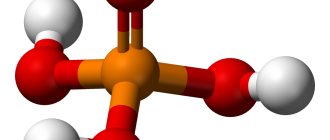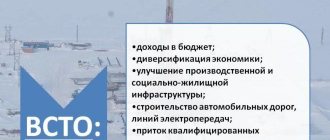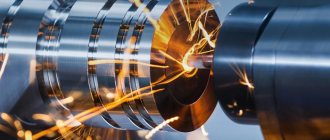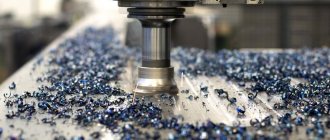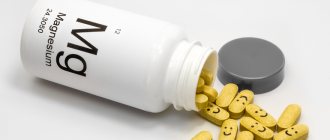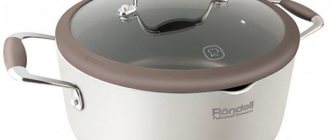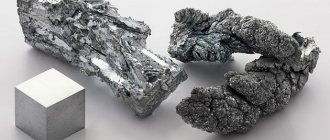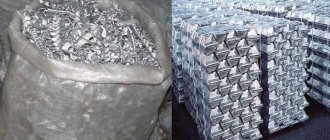In this article:
1. Obtaining titanium
2. Titanium refining 2.1. Obtaining titanium ingots
Titanium is characterized by high mechanical strength, corrosion resistance, heat resistance (tmelt = 1660 °C) and low density (4.51 g/cm3). It is used as a structural material in aircraft construction, as well as in the construction of vessels intended for transporting concentrated nitric and dilute sulfuric acids.
TiO2 dioxide is also used for the production of titanium white and enamel.
The most common raw material for the production of titanium and titanium dioxide is ilmenite concentrate, isolated during the enrichment of titanomagnetite iron ores, which contains, %: 40-60 TiO2, ~ 30 FeO, ~ 20 Fe2O3 and 5-7 gangue (CaO, MgO, Al2O3 , SiO2), with titanium in the form of the mineral ilmenite FeO • TiO2.
History of discovery
The appearance of a new element is associated with the names of Gregor and Klaproth. Both singled it out almost simultaneously in 1791 and 1795. respectively.
Martin Heinrich Klaproth
In 1805, it was isolated again by Vauquelin from anatase. Moreover, pure titanium was obtained in Holland more than a century after its isolation.
Vacuum separation of the reaction mass
Separation is carried out to separate the titanium sponge from magnesium and magnesium chloride. The separation process consists of heating the reaction mass to 900 – 950 °C in a sealed electric heating furnace device, in which a vacuum is created. In this case, part of the magnesium chloride is removed in liquid form, and the rest of the magnesium chloride and magnesium are evaporated. After cleaning, the titanium sponge is sent to melting.
Melting titanium sponge in vacuum arc furnaces. Melting sponge using the vacuum-arc remelting method is the main method of processing it into ingots. The furnace vacuum protects titanium from oxidation and helps clean it from impurities. The resulting titanium ingots are remelted to remove defects, using them as consumable electrodes. After this, the purity of titanium is 99.6 - 99.7%. After secondary remelting, the ingots are used for pressure treatment (forging, stamping, rolling).
Being in nature
In nature, titanium is presented in the form of compounds with oxygen. Pure forms do not occur.
Under the influence of meteorological conditions, the structure approaches corundum (a compound of aluminum with oxygen). It is found in marine clay, in aluminum ores with iron and silicon.
Titanium is presented in minerals: titanite, titanomagnetite, rutile. Australian, Brazilian, and Canadian deposits of the latter are known. The mineral is presented in the form of bucrite and anatase.
A widely encountered mineral is iron titanate (ilmenite). Large deposits are represented in Russia and North America.
Titanium investment casting
This method is more often used when casting small-sized castings with complex configurations or thin walls.
Titanium investment casting
Models are made of wax or polystyrene. The model completely repeats the configuration of the finished product, but has dimensions increased by the amount of casting shrinkage. The model also includes small vertical rods up to the level of the mold fill, used to form injection holes. Molten metal enters the mold through the sprues. The models are combined into blocks, which are placed in a flask, which is filled with highly dispersed graphite powder. Compaction is carried out using the vibration method. To achieve better compaction of the powder, compaction is carried out layer by layer. When ready, the mold with the model block is placed in a vacuum chamber and the melt is poured into it.
The hot liquid metal melts the model material and displaces it in the form of gases directly through the walls of the mold. The melt fills the mold, exactly repeating all the details of its relief. Cooling of castings is carried out according to a special schedule to reduce the likelihood of residual stresses in the metal.
Large deposits
China occupies the leading position, followed by the Russian Federation and North America (Canada). The largest deposit where titanium is mined in the Russian Federation is located on the territory of the Komi Republic and is called the Yaregskoye oil field.
The top ten countries for titanium mining include:
- USA;
- India;
- Australia;
- SOUTH AFRICA;
- Sweden;
- Norway;
- South Korea.
World reserves and production of titanium
Present in Canada, about 1/5 of world production comes from ilmenite ores. In China, 1/10 of the output is provided by the Lac Tico field.
The Russian Federation produces less than 1% of titanium concentrate. However, the Komi field is recognized as the second largest after China. Also, loparite ores are exported mainly by Russia (Lovozersk). The latter are used in the production of rare earth metals (including titanium).
Obtaining titanium
The metal source is titanium dioxide.
Its formation occurs during the processing of ilmenite. As a result, titanium slag is formed, which is subjected to further processing. Sulfuric acid is added to the concentrate, which produces titanium dioxide.
Another method is to combine with carbon (coke), chlorine and further heating in the presence of magnesium.
Calcium reduction of titanium dioxide is also used. The last process involves conducting an electric current, which leads to the decomposition of calcium oxide (oxygen at the anode and calcium itself).
Oxygen acts as an oxidizing agent, calcium, being a metal, moves to the cathode, simultaneously reducing titanium. The process happens several times. The outcome of the reaction is a titanium sponge that requires cleansing.
Titanium slag production
The main purpose of this process is to separate iron oxides from titanium oxide. To do this, ilmenite concentrate is melted in a mixture with charcoal and anthracite in electric furnaces, where iron oxides and part of titanium are reduced according to the reaction:
3(FeO TiO2) + 4C = 3Fe + Ti3O5 + 4CO
The reduced iron is carburized, forming cast iron, which collects at the bottom of the furnace bath, separating from the rest of the slag mass due to the difference in their specific gravities. Cast iron and slag are poured separately into molds. The resulting titanium slag contains 80 – 90% TiO2.
Physical properties
The element is located in the fourth group in the system of D.I. Mendeleev, at number 22. In the compound, the atom has valency (II). The electronic configuration is represented by the formula: [Ar] 3d24s2.
Atomic weight (mass) is about 47.9 amu. The transition of alpha titanium to beta titanium occurs at a temperature of 8830C. The heat of fusion is 18.8 kJ/mol. Boils at 31800C. It has a thermal conductivity of 22.09 W/(m*K).
Titanium has high malleability, ductility, and low hardness. However, alloys containing titanium are highly hard but brittle compounds.
The silvery substance, related to metals in structure, has a bluish tint. Has low density. High melting point (16700C).
In compounds, Ti can exhibit an oxidation state of (+2) (Ti+2H2, Ti+2O, Ti+2(OH)2, Ti+2F2, Ti+2Cl2, Ti+2Br2), (+3) (Ti+32O3, Ti+3(OH)3, Ti+3F3, Ti+3Cl3, Ti+32S3) and (+4) (Ti+4F4, Ti+4H4, Ti+4Cl4, Ti+4Br4).
Where is it used?
Titanium is as strong as steel, but half the weight. It is twice as strong as aluminum, but is only 60% heavier. These advantages determine the use of titanium as a metal by humans.
Industry
Titanium alloys are the number one structural material for builders of rockets, airplanes, and ocean liners. More often they are made from alloys with other metals (especially nickel and aluminum).
Preparation of a titanium frame for an F-15 fighter before and after pressing on an Alcoa stamping press with a force of 45 thousand tons, May 1985
Titanium is lighter than other metals, but can operate at high temperatures.
There are other areas of application of metal:
- Pipes, pumps, and other equipment for working with aggressive liquids.
- Military-industrial complex - armored vests, submarine hulls, missile and aircraft parts.
- Installations for water desalination and air purification.
- Source for the production of pulp and paper.
- Car parts, agricultural machinery, food industry equipment.
- Sport equipment.
More than half of the substance's compounds are taken by manufacturers of varnishes and paints. This is, for example, titanium white.
More and more products made of titanium are falling into the IT sector: housings, filling of mobile phones, and other gadgets.
Medicine
Durable metal is friendly to processes occurring in the human body. Therefore, it is actively used as a material for prosthetic limbs and dental implants. Medicine appreciates its property of painlessly merging with bone tissue. Therefore, titanium is one of the metals of the future.
Safety for the tissues of the human body has made it possible to use metal for piercing.
Other areas
Luxury watch cases are made from titanium. This is the material of jewelry.
Titanium Alloy Watch
The substance is used to “gild” the domes of temples and decorative items. Quadrivalent chloride “creates” a smoke screen and haze on the glass.
Food additive E171 is white titanium dioxide (TiO2), a food coloring.
Chemical properties
It is resistant to corrosion and has properties similar to chromium-nickel steel. The latter is due to the film formed on its surface. Air does not change mechanical properties.
When heated above 6000C, the metal becomes brittle and oxygen absorption increases. When heated above 9100C, it interacts with gaseous carbon compounds and reabsorbs nitrogen.
When hydrogen is added, titanium acquires “hydrogen embrittlement.” This effect is manifested by increased fragility during voltage surges. Resistant to acids.
Use of titanium and its alloys
There are several technical alloys with different markings VT1-00; VT1-0. Both include:
- carbon;
- oxygen;
- nitrogen;
- hydrogen;
- iron;
- silicon.
However, in the first, the content of the presented elements is higher, which determines its advantages over VT1-0.
When alloyed with molybdenum, vanadium, iron, titanium stability (or resistance) to temperature influences increases. When aluminum is added, on the contrary, a decrease occurs - this is used in industry, increasing the range of chemical transformations of titanium.
Used in rocket construction. Sheathing and various units are made on the basis of Ti. The company produces engine compressors and storage tanks. Titanium has found application in aircraft construction because it slows down the destruction of devices.
Low thermal conductivity made it possible to use it for the manufacture of fire partitions. In shipbuilding it prevents corrosion in sea water.
The table provides information on the use of titanium depending on its properties.
| High corrosion resistance | Pipes, heat exchangers, reactors |
| Low modulus of elasticity relative to steel | Springs, rods in mechanical engineering |
| Lightness, low immune response | Prosthetics in medicine |
| Color preservation | Household items, frames, frames |
| Durability | Facade, building decoration, creation of monuments, powders, paints |
| Titanium alloys: superior to steel in specific strength | Creation of steel for armor |
One department, many ideas
The Department of Electrical Engineering of the Polytechnic Institute of Siberian Federal University is a real center of innovative ideas for industry. The head of the department, Viktor Nikolaevich Timofeev (Professor, Doctor of Technical Sciences) heads the Research and Production Center for Magnetic Hydrodynamics. Once upon a time, this enterprise participated in the very first grant programs with the Innovation Promotion Fund, and today it is the largest taxpayer enterprise in the Oktyabrsky district of Krasnoyarsk. SPC MGD is engaged in research and production of new equipment for the metallurgical industry. Clients include RUSAL, Kazakhstan Electrolysis Plant, Armenian and many others; 10% of the world's aluminum is produced using equipment developed by the Krasnoyarsk company.
Meanwhile, the company takes many innovative ideas from the already mentioned Department of Electrical Engineering. Our interlocutors were department professor Maxim Khatsayuk and assistant Alexy Maksimov - both managed to receive grant support for their research at one time and are now working on the further implementation of their plans, as well as the ideas of their colleagues.
For example, Maxim Khatsayuk’s project was called “Induction unit with a toroidal channel of elliptical cross-section.” “Induction units” are called an electric furnace transformer with a channel through which metal molten by induction heating flows. However, a problem arose in the industry for a long time: this very channel became clogged with metal over time, creating problems in use. Maxim's project proposed to solve this problem due to the unique shape of the channel.
“A hypothesis was put forward: if the channel is made toroidal, with an elliptical cross-section, a transit flow appears through the channel. I did the project in 2012-2013, even before defending my PhD. He was one of those who go beyond the line in investing because of the high risks. Neither large industrial enterprises nor engineering companies are ready to finance projects at this stage; additional support was needed. Initially, UMNIK received a grant, but within the framework of one grant it is impossible to grow an idea into an industrial design... Therefore, there are other grants - “START”, “Export” and so on. Subsequently, colleagues joined this work, and the project itself received additional financial support from private investors. As a result, further development led to the emergence of pilot-industrial equipment, which is used in the foundry at the Scientific and Production Center MHD, demonstrates encouraging results and has great prospects for metallurgy,” says Maxim Khatsayuk.
One of these projects was the work of the current assistant of the department, Alexy Maksimov - in the future, it can change titanium production and make products from this material more accessible.


